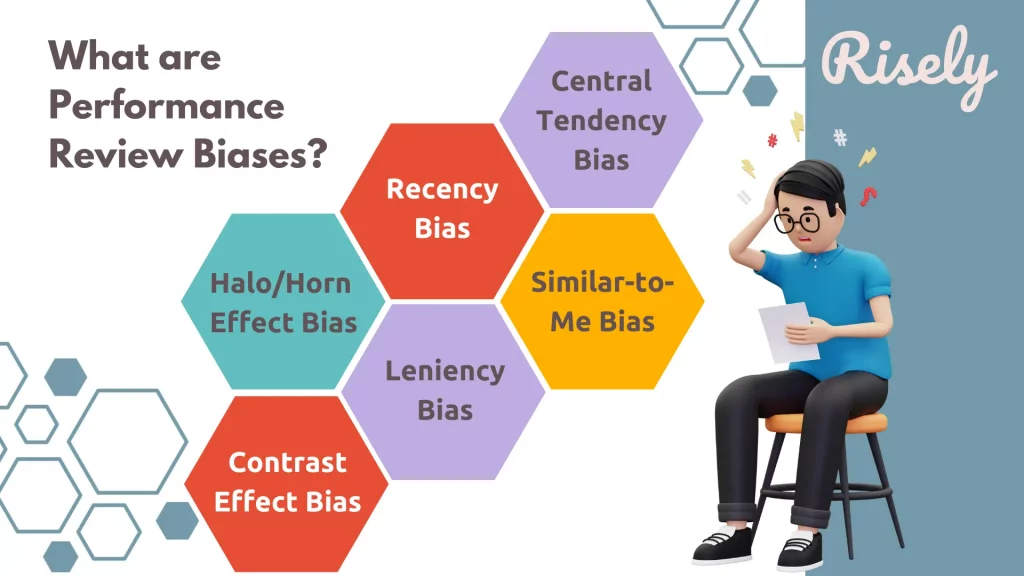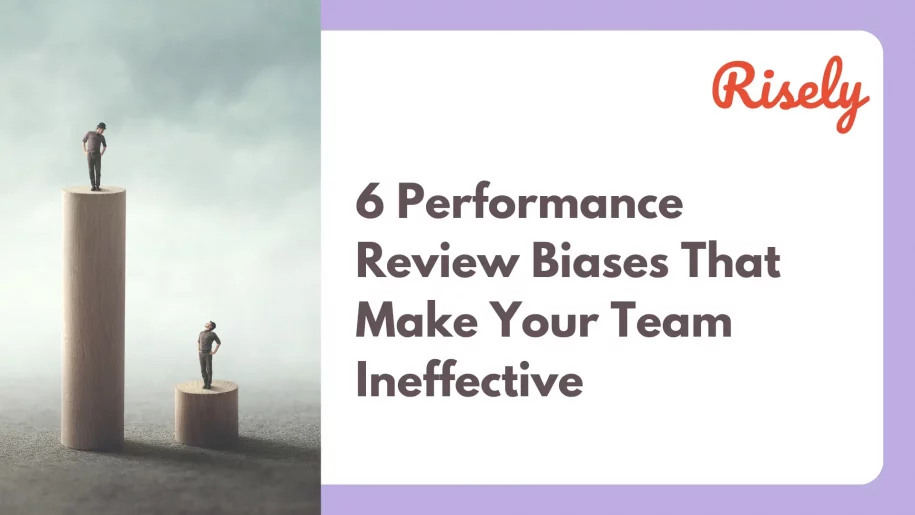6 Performance Review Biases That Make Your Team Ineffective
As a manager, you want your team to be effective and productive. One of the critical factors in ensuring that is conducting performance reviews. However, did you know that factors such as biases can impact the effectiveness of these reviews? Biases can lead to unfair evaluations, low morale, and even turnover. In this blog post, we will discuss common biases in performance reviews and how they can negatively impact your team’s productivity. We will also provide tips on recognizing and preventing these biases from influencing your performance review process, ensuring a fair evaluation for all your team members.Biases in Performance Reviews
Performance reviews are susceptible to various biases, which can significantly impact a team’s overall effectiveness. These biases undermine the objectivity and fairness of the review process, leading to inaccurate assessments of employee performance. Organizations must recognize these biases to create a more equitable and inclusive review process. Biases such as primacy, first impression, and intuition can result in unfair evaluations, while rater bias and stereotypes can influence ratings. It hurts employee morale and motivation. By addressing and mitigating biases, organizations can ensure that their performance appraisal process is fair, accurate, and effective. Read more: How to overcome the top 10 manager biases at work?What do performance review biases look like?
Biases in performance reviews encompass the systematic errors or deviations from objectivity that occur when evaluating an employee’s performance. Unconscious factors can influence these biases, which shape a manager’s perception of an employee’s abilities and contributions. As a result, they can lead to unfair treatment and inaccurate judgments. Understanding the various types of biases is crucial to identifying and minimizing their impact on performance reviews. Such actions can help managers ensure that the growth and development of team members continue unhindered by creating a fair and objective appraisal process that promotes equality and eliminates biases.Signs of Biases in Performance Reviews
Signs of biases in performance reviews can manifest in various ways, impacting the fairness and objectivity of the evaluation process. One common symptom is when managers disproportionately focus on recent events, neglecting to consider an employee’s overall performance. It can lead to inconsistent ratings across different employees, indicating a lack of objectivity. Biased evaluations may also be evident when assessments are overly positive or negative without proper justification. Additionally, biases can be observed in employee ratings based on specific characteristics. A few other common signs of biases include:- Different behavior with different team members
- Consistent rewards or punishments for some team members
- Assumptions about the attitude, habits, and nature of people
- High presence of “like-minded” individuals in the team who belong to the same in-group
- Shutting down suggestions or feedback from specific team members repeatedly
- Judging competence on non-work related metrics
Impact of Biases on Team, Managers, and Individual Contributors
Biases in performance reviews can harm the entire team, leading to a demotivating work environment with lowered morale and decreased productivity. Employees perceiving biases as unfair treatment can reduce trust in their managers and the organization. Additionally, biases can hinder individual contributors from receiving proper recognition and opportunities for career advancement. It’s important to note that managers who exhibit biases in performance reviews may miss out on identifying the potential of their team members, which can ultimately hinder the team’s overall success. Organizations can create a more equitable and effective performance appraisal process by being aware of these biases and actively working to mitigate their impact.
Common Performance Review Biases
Central Tendency Bias
Managers often fall into the trap of Central Tendency Bias during performance appraisals. This bias occurs when they rate all employees within the average range, regardless of their performance. The main issue with this bias is that it fails to differentiate between high and low performers, resulting in missed opportunities to reward top performers and address poor performance effectively. Over time, this bias can create a stagnant work culture and hinder team growth.How do we overcome the central tendency bias?
Mitigating Central Tendency Bias involves encouraging managers to provide specific and accurate feedback for each employee, ensuring they are evaluated based on their contributions rather than being lumped together with the average performers.Recency Bias
Recency Bias, one of the common performance review biases, occurs when recent events disproportionately impact an employee’s performance evaluation. This bias may overshadow their long-term contributions and achievements. Managers should be mindful of considering an employee’s performance over a defined period rather than solely focusing on recent events to create a more comprehensive plan and enable the team to put persistent efforts at work.How can we overcome the recency effect in performance reviews?
Implementing regular check-ins and documenting performance throughout the year can help mitigate Recency Bias. Training managers to evaluate performance based on specific criteria can also reduce the influence of this bias. By doing so, organizations can ensure a fairer appraisal process considering the employee’s overall performance rather than just the most recent events.Similar-to-Me Bias
The Similar-to-Me Bias refers to managers’ tendency to favor employees with similar characteristics or backgrounds. The sense of familiarity can pre-dispose managers to select similar individuals for hiring, promotions, and other opportunities. This bias can harm diversity and inclusion efforts within the organization and lead to unfair treatment. Moreover, it promotes groupthink and limits the scope of a team’s problem-solving approaches.How can managers beat the similar-to-me bias?
An active attempt to ensure awareness is the first step to mitigate this bias. Managers must frequently seek diverse perspectives to ensure they are not falling into this trap. Implementing structured performance criteria and evaluation processes can minimize the impact of this bias. Encouraging managers to consider a wide range of competencies and achievements when assessing employees can further reduce the influence of Similar-to-Me Bias.Halo/Horn Effect Bias
The Halo/Horn Effect Bias, a common bias in performance appraisals, occurs when a single positive or negative trait influences the overall evaluation of an employee’s performance. This bias can lead to an inaccurate and skewed assessment of an employee’s capabilities, as one exceptional quality or poor performance may overshadow other aspects.How do we beat the halo and horn effect bias in performance reviews?
Considering the team’s performance across various criteria is essential in beating this bias. It helps formulate a more rounded and objective picture that steals focus away from specific events. Providing detailed and constructive feedback can also help counteract the impact of the Halo/Horn Effect Bias. Furthermore, training managers to recognize and avoid this bias can contribute to a more objective and fair performance review process.Leniency Bias
Managers exhibiting Leniency Bias consistently rate employees more favorably regardless of their performance. This bias can lead to inflated ratings and a lack of differentiation between high and low performers. Addressing poor performance becomes challenging when managers succumb to Leniency Bias. Eventually, as teams miss out on weak areas that needed interventions long ago, the problems compound to an even higher level – creating consistent performance issues.How to beat the leniency bias?
Implementing clear performance standards and providing training on accurate performance evaluation is crucial to mitigate its impact. Regular calibration sessions among managers can also ensure greater consistency in performance ratings. By addressing Leniency Bias head-on, organizations can create a fair and objective performance appraisal process that encourages improvement and rewards genuine achievements.Contrast Effect Bias
The contrast effect bias in performance reviews refers to comparing one employee’s performance to another, rather than evaluating them based on their merits. This bias can significantly impact the fairness of evaluations and result in misinterpretation of an employee’s abilities. Moreover, this bias ensures that high and low performers do not get access to the opportunities they need, as their performance is pitted against someone instead of being analyzed objectively to aid growth.How can managers beat the contrast bias in performance reviews?
Establishing specific evaluation criteria that help avoid making comparisons between employees is essential to beat this bias. Managers can ensure fair and unbiased assessments by focusing on each employee’s performance independently. Creating a company standard for performance reviews and providing training on recognizing and overcoming biases can also help make a more effective and equitable team.Other Interesting Reads
Overcoming Performance Review Biases
Overcoming biases that skew evaluations are crucial to effective performance reviews that can also enable growth for the team and the individuals.Tips to Overcome Biases in Performance Reviews
- Train managers to recognize and overcome biases, including the halo effect and recency bias, for fair performance reviews.
- Emphasize the importance of using data, objective metrics, and subjective opinions for accurate employee evaluations.
- Encourage self-evaluation and feedback from employees to gain a holistic view of performance.
- Conduct regular calibration sessions to ensure consistency in evaluations.
- Provide ongoing feedback and development opportunities throughout the year, not just during annual reviews, to promote growth and improvement.
- Explore anonymous peer or 360-degree evaluations to gather multiple perspectives and reduce the impact of individual biases.
Using Performance Review Methods that Limit Biases
- Adopt a standard for performance reviews: It is essential to use performance review methods that limit biases to ensure fair and objective performance evaluations. A mix of tech-enabled tools and feedback from multiple sources can help you get this right.
- Focus on objective aspects: One practical approach is to be specific in the evaluation process, focusing on tangible achievements rather than subjective opinions. It helps provide a clear and unbiased assessment of an employee’s performance. Additionally, incorporating objective metrics, such as sales numbers or project completion rates, helps remove potential biases based on personal opinions.
- Incorporate feedback from multiple sources: Another way to limit biases is by encouraging feedback from various sources, including peers and subordinates. This gives a more comprehensive view of an employee’s performance and reduces the chances of biases creeping in. 360-degree feedback is a great way to get this right.
- Don’t leave everything for annual reviews: Evaluating performance over a more extended period, rather than just the most recent weeks or months, helps avoid recency bias. Hence, make sure that your reviews are spread out to suit your team’s work. You can incorporate mid-year reviews, self-evaluation checks, and one-on-one meetings for development conversations to balance the biases.
- Enable expressions: Using anonymous surveys to gather feedback can also be beneficial as it minimizes unconscious biases. Employees feel more comfortable sharing their honest opinions without fearing repercussions by ensuring that feedback is anonymous.
- Lastly, make an effort: Finally, being aware of and actively working to overcome our biases is crucial in implementing performance review methods that limit biases. Very often, biased behavior happens like second nature without ample recognition or thought. Hence, it’s essential to sit back and introspect the paths our thoughts take and the conclusions we finally arrive at – some introspection can go a long way toward a more fulfilling professional experience.
Conclusion
In conclusion, being aware of the biases that can arise during performance reviews is crucial. These biases, such as central tendency bias, recency bias, similar-to-me bias, halo/horn effect bias, leniency bias, and contrast effect bias, can negatively impact your team’s effectiveness. By recognizing and addressing these biases, you can ensure fair and accurate performance evaluations that lead to better outcomes for both the individuals and the team as a whole. Implementing strategies such as providing clear evaluation criteria, training managers on bias awareness, and using performance review methods that limit biases can help overcome these biases and create a more effective and unbiased review process. It is essential to prioritize fairness and objectivity in performance evaluations to foster a positive and productive work environment.Biased views can hurt your growth. Learn how to think critically.
Test your critical thinking skills for free with Risely’s self-assessment for managers.
Other Related Blogs
How to build and retain high performing employees? | Laletha Nithiyanandan
How to build and retain high performing employees? | Laletha Nithiyanandan Are you really an HR if you have not spent hours chasing the ideal high performing employees for your…
How Can You Build A High Performing Culture? 7 Hacks
How Can You Build A High Performing Culture? 7 Hacks We have all heard of dream teams and tried to build them with varying levels of success and failure. Among…
10 Effective Manager Performance Goals to Drive Team Success
10 Effective Manager Performance Goals to Drive Team Success You’re sitting across from a manager in a performance review meeting. They seem unsure, disconnected from the company’s vision, and oblivious…
How to Build a High-Performing Team?
How to Build a High-Performing Team? Creating a high-performing team is a goal that every organization aspires to achieve. A high-performing team achieves superior results and can quickly adapt to…


